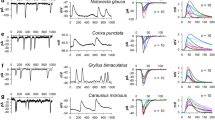Summary
-
1.
Intracellular receptorpotentials were recorded with microelectrodes from single visual cells of the ventral part of eyes of imagines and from visual cells of nymphs of Aeschna cyanea and Aeschna mixta. They are monophasic depolarizing. Their amplitude and form depend on the light intensity (Fig. 2).
-
2.
Curves showing potential amplitude as a function of light intensity are parallel for different wavelengths in a single visual cell.
-
3.
The relative sensitivity of single visual cells was measured between 336 and 678 nm.
-
4.
In the ventral area of the eyes of imagines there were found two types of receptors: a) λmax = 519 nm with a secondary maximum at 356–370 nm. The 519 nm maximum was determined from 30 single cells. In the case of 34 other cells it shifts from 458 nm (4 cells) to 494 nm (23 cells), to 536 nm (3 cells) and to 550 nm (4 cells). The reasons for this shifting are discussed, b) λmax between 412 and 432 nm (2 cells) with a secondary maximum at 356 nm.
-
5.
Four receptor types were found in nymphs: a) λmax at 519 nm (most frequent with 15 cells). In 6 other cells of this type λmax shifted to 494 nm (3 cells) and to 536 nm (3 cells); b) λmax at 356 nm with a secondary maximum at 412 nm (2 cells); c) λmax at 615 nm (1 cell); d) λmax at 336 nm or at a still shorter wavelength (1 cell).
Zusammenfassung
-
l.
Von einzelnen Sehzellen des ventralen Augenbereichs der Imagines und von Sehzellen der Larven von Aeschna cyanea und Aeschna mixta wurden mit Mikroelektroden intrazellulär Rezeptorpotentiale abgeleitet. Sie sind monophasisch depolarisierend. Ihre Amplitude und Form hängen von der Lichtintensität ab (Abb. 2).
-
2.
Die Kurven der Potentialhöhe in Abhängigkeit von der Intensität verlaufen bei verschiedenen Wellenlängen bei der einzelnen Sehzelle parallel zueinander (Abb. 3).
-
3.
Es werden die relativen Empfindlichkeitskurven einzelner Rezeptorzellen zwischen 336 und 678 nm gemessen.
-
4.
Im ventralen Augenbereich der Imagines wurden zwei Rezeptortypen gefunden: a) λmax = 519 nm mit einem Nebenmaximum bei 356–370nm. Das Hauptmaximum lag bei 30 gemessenen Einzelzellen bei 519 nm; bei 34 anderen Sehzellen streut es aber zwischen 458 nm (4 Zellen), 494 nm (23 Zellen), 536 nm (3 Zellen) und 550 nm (4 Zellen). Die Gründe für diese Streuung bei den Messungen werden diskutiert. b) λmax zwischen 412 und 432 nm (2 Zellen) mit einem Nebenmaximum bei 356 nm.
-
5.
Bei den Larven wurden vier Rezeptortypen gefunden: a) am häufigsten ist der Rezeptor mit λmax = 519 nm (15 Sehzellen); in 6 anderen Sehzellen lagen die Streuungen von λmax bei 494 nm (3 Sehzellen) und 536 nm (3 Sehzellen); b) λmax= 356 nm mit dem Nebenmaximum bei 412 nm (2 Sehzellen); c) λmax=615 nm (1 Sehzelle); d) λmax=336 nm oder eine kürzere Wellenlänge (l Sehzelle).
Similar content being viewed by others
Literatur
Autrum, H.: Colour vision in man and animals. Naturwissenschaften 55, H. 1, 10–18 (1968).
—, u. M. Gallwitz: Zur Analyse der Belichtungspotentiale des Insektenauges. Z. vergl. Physiol. 33, 407–435 (1951).
—, u. V. v. Zwehl: Zur spektralen Empfindlichkeit einzelner Sehzellen der Drohne (Apis mellifica ♂). Z. vergl. Physiol. 46, 8–12 (1962).
—, V. v. Zwehl: Die spektrale Empfindlichkeit einzelner Sehzellen des Bienenauges. Z. vergl. Physiol. 48, 357–384 (1964).
Bennett, R.: Spectral sensitivity studies on the whirligig beetle, Dineutes ciliatus. J. Insect Physiol. 13, 621–633 (1967).
—, J. Tunstall, and G. Horridge: Spectral sensitivity of single retinula cells of the locust. Z. vergl. Physiol. 55, 195–206 (1967).
Briggs, M.: Retinene-I in insect tissues. Nature (Lond.) 192, 874–875 (1961).
Bruckmoser, P.: Die spektrale Empfindlichkeit einzelner Sehzellen des Rückenschwimmers Notonecta glauca L. (Heteroptera). Z. vergl. Physiol. 59, 187–204 (1968).
Burkhardt, D.: Untersuchungen zur spektralen Empfindlichkeit des Insektenauges. Verh. Dtsch. Zool. Ges. Saarbrücken 1961.
—: Spectral sensitivity and other response characteristics of single visual cells in the arthropod eye. Symp. Soc. exp. Biol. 16, 86–109 (1962).
Dartnall, H. J. A.: The interpretation of spectral sensitivity curves. Brit. med. Bull. 9, 24–30 (1953).
Daumer, K.: Reizmetrische Untersuchungen des Farbensehens der Bienen. Z. vergl. Physiol. 38, 413–478 (1956).
Frisch, K. v.: Der Farbensinn und Formensinn der Biene. Zool. Jb., Abt. allg. Zool. u. Physiol. 35, 1–182 (1914).
Gogala, M.: Die spektrale Empfindlichkeit der Doppelaugen von Ascalaphus macaronius Scop. Z. vergl. Physiol. 57, 232–243 (1967).
Goldsmith, T. H.: Do flies have a red receptor? J. gen. Physiol. 49, 265–287 (1965)
Koehler, O.: Sinnesphysiologische Untersuchungen an Libellenlarven. Verh. Dtsch. zool. Ges. 29, 83–90 (1924).
Kühn, A.: Über den Farbensinn der Bienen. Z. vergl. Physiol. 5, 762–800 (1927).
—, u. R. Pohl: Dressurfähigkeit der Bienen auf Spektrallinien. Naturwissenschaften 9, 738–740 (1921).
Langer, H.: Grundlagen der Wahrnehmung von Wellenlänge und Schwingungsebene des Lichtes. Verh. Dtsch. Zool. Ges. Göttingen 30, 195–233 (1966).
Lew, T.: Head characters of the odonata with special reference to the development of the compound eye. Entomologica americana 14, 41–73 (1933).
Mazokhin-Porshnyakov, G. A.: Colorimetric study of colour vision in the dragonfly. Biofizika 4, 427–436 (1959) [Russisch].
Naka, K.: Recording of retinal action potentials from single cells in the insect compound eye. J. gen. Physiol. 44, 571–584 (1961).
Ruck, P.: The components of the visual system of a dragonfly. J. gen. Physiol. 49, 289–307 (1965).
Straub, E.: Stadien und Darmkanal der Odonaten in Metamorphose und Häutung. Z. wiss. Zool. Abt. B, 12, 1–93 (1944).
Wald, G., and P. K. Brown: Human color vision and color blindness. Cold Spr. Harb. Symp. quant. Biol. 30, 345–362 (1965).
Author information
Authors and Affiliations
Additional information
Mit Unterstützung der Deutschen Forschungsgemeinschaft.
Rights and permissions
About this article
Cite this article
Autrum, H., Kolb, G. Spektrale Empfindlichkeit einzelner Sehzellen der Aeschniden. Z. Vergl. Physiol. 60, 450–477 (1968). https://doi.org/10.1007/BF00297940
Received:
Issue Date:
DOI: https://doi.org/10.1007/BF00297940




